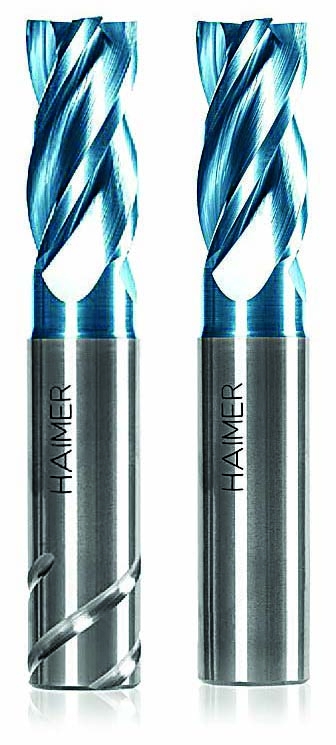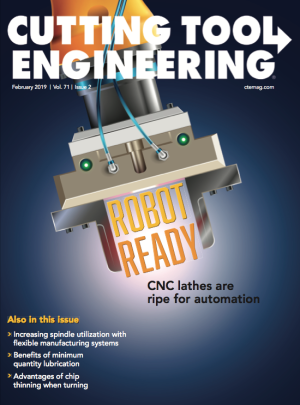Quickly and economically converting powertrains in Jeep vehicles is what Novak Conversions, Logan, Utah, has been all about since 1967. The company makes all its components in-house and always looks for ways to cut the time and costs of creating, designing, building and machining parts.
Novak applies endmills to rough alloy steel and carbon steel splining on transmission input and output shafts. Machinists were accustomed to short tool life and went through a lot of endmills.
Aaron Mikesell, applications engineer at distributor Herrick Industrial Supply Inc., Ogden, Utah, introduced Novak to the Basic Mill from Haimer USA LLC, Villa Park, Illinois.

The solid-carbide Basic Mill from Haimer USA can aggressively rough a range of workpiece materials and is available with (left) or without Safe-Lock shanks. Image courtesy of Haimer USA
“They tested it for about two weeks and a couple of different applications before we got feedback,” Mikesell said. “It ran excellent. They were completely impressed with the speed and the life of the endmill. And on top of all that, they were extremely surprised with the price.”
The test involved two parts. One required a plunge cut into 3⁄4"-thick steel before being finished with the same tool. Another part was made with a 3⁄8"-dia. endmill.
“It was like night and day,” said Matt Olsen, machinist and CNC programmer at Novak. “We were blown away with the time savings and put it in one machine that we cut splines in. I was skeptical about the shafts. They are done in a lathe with a milling bit, but you don’t even hear it. It’s amazing. We’ve actually used them in manual applications, and the performance is insane.”
Olsen has used the Basic Mill for almost two years, and the results continue to delight. When the old endmills were used during the customary busy season of January to July, Novak went through two or three endmills per week.
“Now we’re still using the
ones that I bought three months ago,” Olsen said. “It’s a huge
improvement.”
With the former tool, it took about 10 minutes to rough a transmission shaft. Using the Basic Mill, roughing takes about six minutes, a savings of four minutes per shaft.
“The biggest thing that I like is the cost,” Olsen said. “A 1⁄2" endmill for $55? That’s unheard of. They last forever. Lots of times, you can’t even hear the endmill because it runs so quiet.”
Before, Novak produced perhaps 50 parts in a day. With the Basic Mill, the number is from 100 to 120. The company also gets two to three times more life from each tool when milling big plates.
Olsen said a certain increase in sound indicates when a new endmill is needed.
“You can hear it and take the tool out and look at it on a microscope,” he said. “The tools are usually fine. It’s the coating on the tools that usually fails before the tool. Once the coating goes, you lose the edge. So we change it out right there and then. And with the low cost, you don’t feel bad changing it out.”
Finishing tools last quite a bit longer as well, Olsen said, because roughing tools last longer. When roughing tools take longer to start to fail, finishing tools do not have to work harder to make up for the roughing tools.
Mikesell said the production facility runs a lot of the same parts again and again.
“They really can look at it on a qualitative level,” he explained. “The biggest thing for Novak was the performance-to-price ratio—what they got out of it for the money. That’s really the same for all my customers.”
About 30 Herrick customers use the Basic Mill for various applications. Mikesell said many companies use it as their general-purpose stock endmill because its price is hard to beat.
“I have it in play from aerospace to automotive to food and beverage manufacturing,” he said. “It’s used all over the place. It is a good endmill to do plug and play.”
Contact Details
Related Glossary Terms
- computer numerical control ( CNC)
computer numerical control ( CNC)
Microprocessor-based controller dedicated to a machine tool that permits the creation or modification of parts. Programmed numerical control activates the machine’s servos and spindle drives and controls the various machining operations. See DNC, direct numerical control; NC, numerical control.
- endmill
endmill
Milling cutter held by its shank that cuts on its periphery and, if so configured, on its free end. Takes a variety of shapes (single- and double-end, roughing, ballnose and cup-end) and sizes (stub, medium, long and extra-long). Also comes with differing numbers of flutes.
- gang cutting ( milling)
gang cutting ( milling)
Machining with several cutters mounted on a single arbor, generally for simultaneous cutting.
- lathe
lathe
Turning machine capable of sawing, milling, grinding, gear-cutting, drilling, reaming, boring, threading, facing, chamfering, grooving, knurling, spinning, parting, necking, taper-cutting, and cam- and eccentric-cutting, as well as step- and straight-turning. Comes in a variety of forms, ranging from manual to semiautomatic to fully automatic, with major types being engine lathes, turning and contouring lathes, turret lathes and numerical-control lathes. The engine lathe consists of a headstock and spindle, tailstock, bed, carriage (complete with apron) and cross slides. Features include gear- (speed) and feed-selector levers, toolpost, compound rest, lead screw and reversing lead screw, threading dial and rapid-traverse lever. Special lathe types include through-the-spindle, camshaft and crankshaft, brake drum and rotor, spinning and gun-barrel machines. Toolroom and bench lathes are used for precision work; the former for tool-and-die work and similar tasks, the latter for small workpieces (instruments, watches), normally without a power feed. Models are typically designated according to their “swing,” or the largest-diameter workpiece that can be rotated; bed length, or the distance between centers; and horsepower generated. See turning machine.
- milling
milling
Machining operation in which metal or other material is removed by applying power to a rotating cutter. In vertical milling, the cutting tool is mounted vertically on the spindle. In horizontal milling, the cutting tool is mounted horizontally, either directly on the spindle or on an arbor. Horizontal milling is further broken down into conventional milling, where the cutter rotates opposite the direction of feed, or “up” into the workpiece; and climb milling, where the cutter rotates in the direction of feed, or “down” into the workpiece. Milling operations include plane or surface milling, endmilling, facemilling, angle milling, form milling and profiling.
- milling machine ( mill)
milling machine ( mill)
Runs endmills and arbor-mounted milling cutters. Features include a head with a spindle that drives the cutters; a column, knee and table that provide motion in the three Cartesian axes; and a base that supports the components and houses the cutting-fluid pump and reservoir. The work is mounted on the table and fed into the rotating cutter or endmill to accomplish the milling steps; vertical milling machines also feed endmills into the work by means of a spindle-mounted quill. Models range from small manual machines to big bed-type and duplex mills. All take one of three basic forms: vertical, horizontal or convertible horizontal/vertical. Vertical machines may be knee-type (the table is mounted on a knee that can be elevated) or bed-type (the table is securely supported and only moves horizontally). In general, horizontal machines are bigger and more powerful, while vertical machines are lighter but more versatile and easier to set up and operate.
END USER:
Novak Conversions, 877-602-1500, www.novak-adapt.com
SOLUTION PROVIDER:
Haimer USA LLC, 630-833-1500, www.haimer-usa.com
CHALLENGE:
Increase the speed and reduce the cost of milling components.
SOLUTION:
A longer-lasting, more productive endmill.



